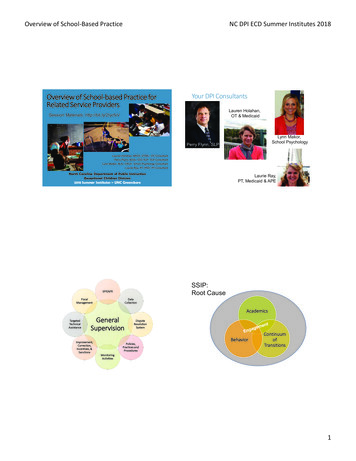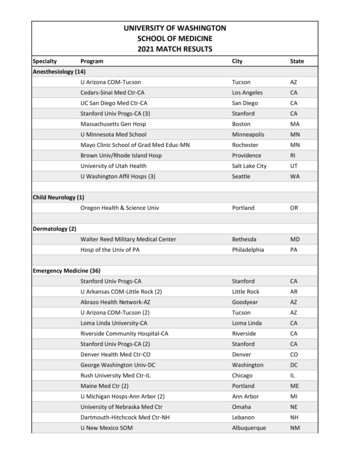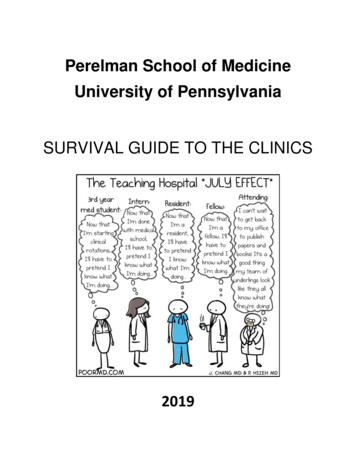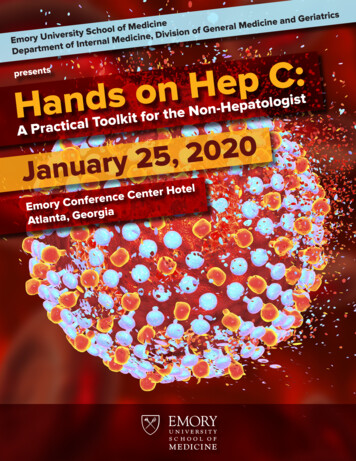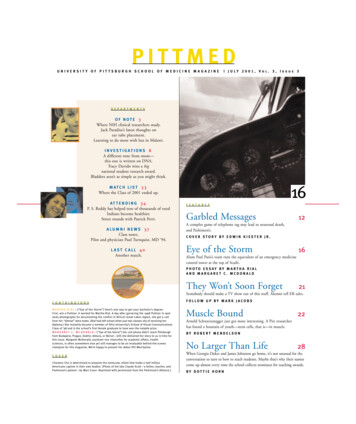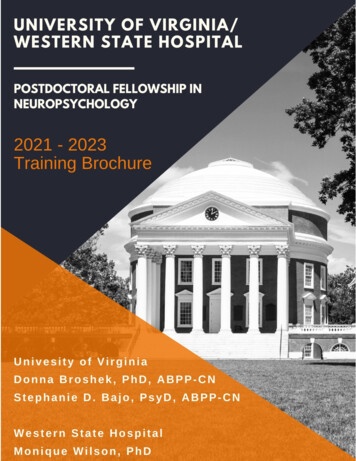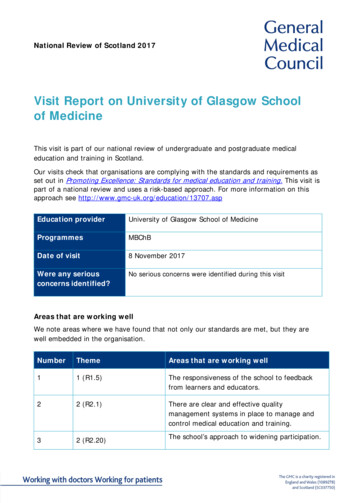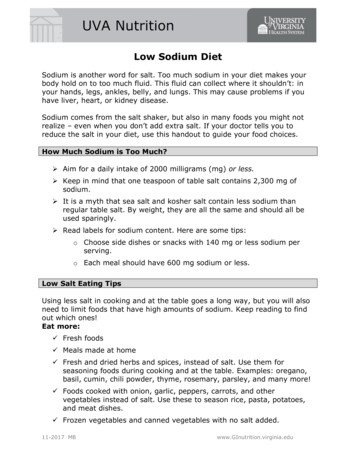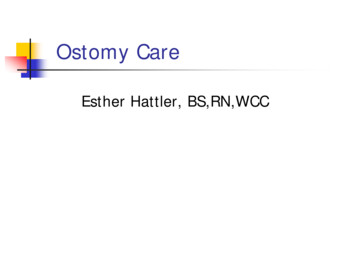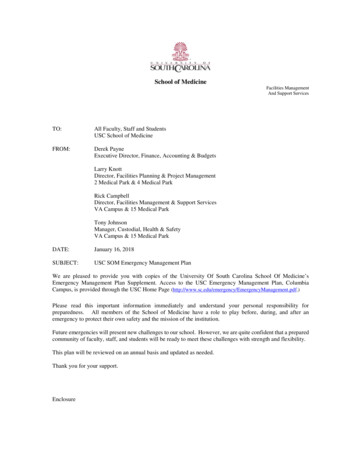
Transcription
School of MedicineFacilities ManagementAnd Support ServicesTO:All Faculty, Staff and StudentsUSC School of MedicineFROM:Derek PayneExecutive Director, Finance, Accounting & BudgetsLarry KnottDirector, Facilities Planning & Project Management2 Medical Park & 4 Medical ParkRick CampbellDirector, Facilities Management & Support ServicesVA Campus & 15 Medical ParkTony JohnsonManager, Custodial, Health & SafetyVA Campus & 15 Medical ParkDATE:January 16, 2018SUBJECT:USC SOM Emergency Management PlanWe are pleased to provide you with copies of the University Of South Carolina School Of Medicine’sEmergency Management Plan Supplement. Access to the USC Emergency Management Plan, ColumbiaCampus, is provided through the USC Home Page df.)Please read this important information immediately and understand your personal responsibility forpreparedness. All members of the School of Medicine have a role to play before, during, and after anemergency to protect their own safety and the mission of the institution.Future emergencies will present new challenges to our school. However, we are quite confident that a preparedcommunity of faculty, staff, and students will be ready to meet these challenges with strength and flexibility.This plan will be reviewed on an annual basis and updated as needed.Thank you for your support.Enclosure
USCSCHOOL OF MEDICINEEMERGENCY MANAGEMENTSAFETY PLANFor USC School of Medicine Faculty, Staff and Students2017-2018
USC School of Medicine Emergency Management Safety PlanTABLE OF CONTENTSLetter of IntroductionEmergency Reporting . . .iPurpose . 1Implementation of Emergency Evacuation . . . . 2How to Respond to an Emergency 3-5Emergency Spill Kits . . . 4How to Assist People with Disabilities during an Evacuation . . . 6-7Fire Drills /Emergency Evacuations . . . 8-9USC Carolina Alert Emergency . . . . . .; 10-11Division of Law Enforcement and Safety/Crime Prevention & Safety ResourcesActive Shooter . . . . . . 11-12MapsDorn VA Campus . . . 13Palmetto Richland Medical Park Campus . . . . . 14Palmetto Health Richland . . . . . . 15USC School of Medicine “Work-Related Injury Policy” . . . 16-17Automated External Defibrillator (AED) Policy . . . . . . 17-22Hurricane Preparedness Guide 2017-2018 . . 23-29TO REPORT AN EMERGENCY SITUATION/BOMB THREAT/WORK PLACE VIOLENCE/UTILITIES FAILURE/MEDICAL AID:(ALL LIFE SAFETY EMERGENCIES) . . . . . . . 911 USC Police . . . . . 777-4215 SOM VA Campus Emergency Incident Numbers: (DAYTIME)Facilities Management & Support Services . . 216-3150SOM Custodial, Health & Safety Services . . . 216-3319 USC Environmental Health & Safety . . . 777-5269Radiation SafetyChemical /Biological Safety SOM MP2 & MP4Lillibridge . . . . . . 779-2680(After Hours Emergencies) . . . . . . 351-4807Custodial, Health & SafetyPage i
USC School of Medicine Emergency Management Safety PlanWHEN YOU CALL TO REPORT AN EMERGENCY:TELL THE RESPONDENT:1. The type of emergency2. If there are victims3. The location of the emergency4. Your name, location and phone numberSTAY ON THE PHONE UNTIL THE RESPONDENT ENDS THE CALL(OR OBVIOUSLY IF PERSONAL SAFETY IS AT RISK GO TO ANALTERNATIVE LOCATION).Appendix A -VA Building #9 Contact Information . 30(Research Lab Emergency Call Roster)Appendix B -VA/SOM Animal Facility Emergency Call Roster . 31Appendix C -VA Safety Handbook & Chemical Hygiene Plan 32Appendix D -USC Laboratory Emergency Procedures . . 33-35Custodial, Health & SafetyPage ii
PURPOSE:USC School of Medicine Emergency Management Safety PlanThe University of South Carolina School of Medicine Emergency Management Plan outlinesthe University’s procedures for managing major emergencies that may threaten the health andsafety of the campus community or disrupt its programs and activities. The Plan identifiesdepartments and individuals that are directly responsible for emergency response and criticalsupport services.At the USC School of Medicine, planning ahead for emergencies is part of normal businessplanning and campus life, and all members of the campus community share a responsibility forpreparedness. An emergency can strike anytime or anywhere and a disaster will affecteveryone. Therefore, Every administrative and academic unit is asked to review the USC School ofMedicine/USC Emergency Management Plan to protect personnel and programs andto support campus response and recovery actions. The School of Medicine’sDirector of Facilities Management will distribute the Department EmergencyPlanning Guidelines, along with the University of South Carolina EmergencyManagement Plan, to the various departments on all School of Medicine campuses. The School of Medicine maintains a comprehensive emergency preparedness andsafety training program to mitigate potential hazards and to familiarize faculty, staffand students with emergency procedures.SCOPE:The University of South Carolina School of Medicine Emergency Management Plan guidespreparedness, response, and recovery actions. It applies to a broad range of emergencyincidents, and may be activated during: EarthquakesHazardous Materials ReleasesFloodsFires or ExplosivesExtended Power OutagesMass Casualty EventsHurricanesActive ShooterHostageTornadoesCustodial, Health & SafetyPage 1
USC School of Medicine Emergency Management Safety PlanTo Implement an Emergency Evacuation(See specific evacuation plan for Fire Evacuation) Keep calm Alert Emergency Response personnel to assist in the evacuation (in case offire, fire monitors will assist) Use communication tools that are appropriate for the type of incident and thetime of occurrence: AlarmsPhones away from buildingsMessengersCommunicate clearly and succinctly“We have a(n) emergency.”“Evacuate to .” (gathering place designated duringfire drills)“Take your belongings (quickly), do NOT use elevators.” Check offices, classrooms, labs and restrooms Turn equipment off, if possible Take emergency supplies and staff rosters, if possible Keep exiting groups together Account for personnel Wait at the designated gathering point for further instructionsCustodial, Health & SafetyPage 2
USC School of Medicine Emergency Management Safety PlanHow to Respond to an EmergencyCall 911 – for all life safety emergenciesSee “USC School of Medicine Work-Related Injury Policy” Administer first aid if you are trained (See Attached AED Policy)Do not attempt to move a seriously injured personNotify Supervisor, Department Chair, and the School of Medicine HumanResources FIRE Call 911 - for all life safety emergencies During working hours also call USC Police 777-4215(See Fire Evacuation Policy) Notify supervisor and staff Feel doors for heat If cool, exit carefully If hot, do not open the door If you see smoke, crouch near floor as you exit If you see fire, confine it by closing doors and windows Use extinguishers on small fires only if safe to do so Pull the pin in the handle Aim at the base of the fire Squeeze nozzle, sweep back and forth Evacuate downstairs, go upstairs or to the roof as a last resort Never use an elevator during a fire evacuation Go to the Emergency Assembly Point HAZARDOUS MATERIALS SPILL MINOR RELEASE IN THE LAB Follow lab eyewash, rinse or shower procedures Vacate persons in immediate area if necessary Clean spill if you have suitable training Wear protective equipment Use appropriate kit to contain, neutralize and absorb Collect, containerize, and label waste Call – During Working Hours: 216-3319 (USCSOM Custodial, Health & Safety Services) 216-3150 (USCSOM Facilities Management & Support Services) 777-5269 (USC Environmental Health & Safety)Call – After Working Hours: 777-4215 - USC PoliceCustodial, Health & SafetyPage 3
USC School of Medicine Emergency Management Safety PlanFacilities Management & Support Services or Custodial, Health & Safety Services shallnot clean up hazardous materials. Call 216-3319 to make arrangements to have chemical waste picked up(Custodial, Health & Safety Services)Chemical Waste Pickup Request Form can be found .asp. MAJOR RELEASE IN THE DEPARTMENT Call 777-4215 – (USC Police) 777-5269 – (USC Environmental Health & Safety) 216-3150 – (USCSOM Facilities Management & Support Services) 216-3319 – (USCSOM Custodial, Health & Safety Services) Material spilled, possible injuries: Assist injured persons Isolate contaminated persons Avoid contamination or chemical exposure Close doors or control access to spill site Alert Supervisor, Department Chair Communicate critical spill information to responders Follow evacuation instructionsEMERGENCY SPILL KITS:The USC School of Medicine has two Emergency Spill Kits. The first one is located in Building4 beside the entrance to the Gross Lab and the second one is located in Building 1 beside theentrance to the Instrumentation Resource Facility.In addition to the Emergency Spill Kits, several universal spill kits are stored in the HazardousWaste Storage Room and kitty litter is stored in our Mechanical Rooms for larger spills.All labs are required to maintain a written Laboratory Safety Plan (“LSP”). Within the LSP,they should list the location of each spill kit for their lab.POWER OUTAGE: Assess the extent of the outage in your area Call – 216-3150 – Report the outage to Facilities Management After 4:30 PM and weekends, call USC Police 777-4215 Help co-workers in darkened work areas move to safe locations If practical, secure current experimental work, and then move it to a safelocation. If you move chemicals on carts between floors, get assistance.Hazardous spills are a significant risk during transport.Custodial, Health & SafetyPage 4
USC School of Medicine Emergency Management Safety Plan Keep lab refrigerators or freezers closed throughout the outageUnplug personal computers, non-essential electrical equipment andappliancesOpen windows for additional light and ventilationIf you are asked to evacuate your building, secure any hazardousmaterials work and leave the buildingRelease of personnel after an extended outage is determined by the Officeof the DeanFor other disasters, refer to the University Emergency Management Plan -team/emergency-plans/.Custodial, Health & SafetyPage 5
USC School of Medicine Emergency Management Safety PlanHOW TO ASSIST PEOPLE WITH DISABILITIESDURING AN EVACUATION: TO ALERT VISUALLY IMPAIRED PERSONS TO ALERT PEOPLE WITH HEARING LIMITATIONS Turn lights on/off to gain person’s attention, orIndicate directions with gestures, orWrite a note with evacuation directionsTO EVACUATE PEOPLE USING CRUTCHES, CANES OR WALKERS Announce the type of emergencyOffer your arm for guidanceTell the person where you are going, obstacles you encounterWhen you reach safety, ask if further help is neededEvacuate these individuals as injured personsAssist and accompany to evacuation site if possible, orUse a sturdy chair (or one with wheels) to move the person, orHelp carry individual to safetyTO EVACUATE WHEELCHAIR USERS Non-ambulatory persons’ needs and preferences vary Individuals at ground floor locations may exit without help Others have minimal ability to move-lifting may be dangerous Some non-ambulatory persons have respiratory complications Remove them from smoke and vapors immediately(Stairwell usage during an emergency is for the safe evacuation ofpersonnel, as well as access for emergency responders.) Wheelchair users with electrical respirators get priority assistance Most wheelchairs are too heavy to take down stairs Consult with person to determine best carry options Reunite person with the chair as soon as it is safe to do soWhile an "emergency" by its very definition is an unforeseen event, it also usuallyrequires immediate action.Persons with disabilities have four basic evacuation options:1. Horizontal evacuation. This entails using building exits to gain access to outside groundlevel, or going into unaffected wings of multi-building complexes.Custodial, Health & SafetyPage 6
USC School of Medicine Emergency Management Safety Plan2. Stairway (vertical) evacuation. This means of evacuation means using stairwells to reachground level exits from the building.3. Staying in Place. Unless danger is imminent, remaining in a room with an exteriorwindow, a telephone, and a solid or fire resistant door may be your best option.NOTE: The Stay in Place approach may be more appropriate for sprinkler protected buildingsor buildings where an "area of refuge" is not nearby or available. It may also be moreappropriate for an occupant who is alone when the alarm sounds. A label on the door jamb orframe can identify a fire resistant door. Non-labeled 1 ¾ inch thick, solid core wood doors hungon a metal frame also offer good fire resistance.4. Area of Refuge. With an evacuation assistant, going to an area of refuge away fromobvious danger is another emergency plan option. The evacuation assistants will then goto the building evacuation assembly point and notify the on-site emergency personnel ofthe location of the person with a disability. Emergency personnel will determine iffurther evacuation is necessary.The safest Areas of Refuge are stair enclosures common to high-rise buildings and open-air exitbalconies. Other possible Areas of Refuge include fire-rated corridors or vestibules adjacent toexit stairs and elevator lobbies. Many campus buildings feature fire rated corridor constructionthat may offer safe refuge.Taking a position in a rated corridor next to the stairs is a good alternative to a small stairlanding crowded with the other building occupants using the stairways as a means of egress inan emergency.For fire drills or an isolated and contained fire, a person with a disability may not have toevacuate. Suggested guidelines for different types of disabilities include the following:1. Mobility Impaired - WheelchairPersons using wheelchairs should stay in place, or move to an Area of Refuge with theirassistant when the alarm sounds.2. Mobility Impaired - Non WheelchairPersons with mobility impairments who are able to walk independently may be able to negotiatestairs in an emergency with minor assistance.3. Deaf/Hard of HearingMost buildings on campus are equipped with fire alarm strobe lights; however, some are not.4. Visually ImpairedMost people with a visual impairment will be familiar with their immediate surroundings andfrequently traveled routes.Custodial, Health & SafetyPage 7
USC School of Medicine Emergency Management Safety PlanCustodial and Safety ServicesSchool of MedicineFIRE DRILLS AND OTHER EMERGENCY EVACUATIONSPlease adhere to the following guidelines for emergency evacuation:1.Please advise employees in your department not to call Facilities Managementand Support Services regarding whether or not a fire drill is "real" or whether toexit the building. Facilities Management and Support Services will beevacuating the building the same as all other personnel when a signal is sounded.When you hear the signal to evacuate, please do so promptly.2.Please pay special attention to "2a" and "2b" on the following page.3.Keep your monitor/co-monitor list up-to-date. Please review the attached list ofmonitor/co-monitor names for your department and revise them if necessary.(Please send a copy to the School of Medicine Custodial and Safety Services.)Monitors/Co-Monitors Responsibilities:1.Monitors/co-monitors should:(a)INFORM ALL PERSONNEL NOT TO USE THE ELEVATORS.(b)Inform all employees of the location of the designated assembly point.(Location should be 200'-300' away from the building.)Any close exit may be used to exit the building, but make sure everyonein your group gathers at the same point or can be accounted for byanother department monitor. (Please give a copy of the attached map toall employees in your department.)(c)Make sure all restrooms, darkrooms, and other enclosed rooms arechecked.(d)Make sure all physically impaired employees are assisted in exiting thebuilding.(e)Make sure all visitors to your department are accounted for.(f)Once assembled at the pre-arranged meeting site, take an accurate rollcall so that all employees are accounted for. Monitors/co-monitorsshould use the attached "Emergency Evacuation Log Sheet" for thispurpose. (It may be helpful to have a list of the names of yourdepartmental employees accessible in order that they can quickly bereviewed.)Custodial, Health & SafetyPage 8
USC School of Medicine Emergency Management Safety Plan2.3.(g)After the drill or emergency evacuation, send a copy of this log to theCustodial & Safety Services so that we might make a post-evaluation ofthe results. Also, please notify the Custodial and Safety Services of anysubstitutions of monitors/co-monitors.(a)When the Fire Department responds to a call, only their personnel willcall an "all clear" to return to the building.(b)During a "test drill", designated School of Medicine personnel will callan "all clear" to return to building.DURING AN ACTUAL FIRE:(a)Use the nearest Fire Call Box to notify the Columbia Fire Department.(b)If the fire is large or uncontrollable, close off the area and leaveimmediately.(c)From a safe area, call 911 - if the call is made on the School of Medicinecampus or 911 - if the call is made outside of the School of Medicinecampus.(d)Give emergency personnel all necessary information:(1)(2)(3)(4)4.Location of fire (building, room, etc.)Telephone number from which you are callingAny other pertinent information that is requestedHave someone stay near the telephone in case additionalinformation is needed.BEFORE YOU BEGIN TO FIGHT A FIRE:(a)Make sure everyone has left, or is leaving, the building.(b)Make sure the fire is confined to a small area and that it is not spreadingbeyond the immediate area.(c)Make sure you have an unobstructed escape route to which the fire willnot spread.(d)Make sure that you know the nearest device location, you have read theinstructions, and that you know how to use the extinguisher.It is reckless to fight a fire under any other circumstances. Instead, leaveimmediately and close off the area.NOTE: All faculty, staff, and students should follow the same guidelines in cases ofemergency.Custodial, Health & SafetyPage 9
USC School of Medicine Emergency Management Safety PlanUSC Carolina Alert EmergencyEmergency hotline (recorded outgoing messages only) 803-777-5700CAROLINA ALERTIn an emergency call 911 from any campus phone or cell phoneNon-emergency: 803-777-4215WORKPLACE VIOLENCESigns of Workplace Violence:Consider the specific circumstances when evaluating the following signs. The presence of onecharacteristic may not necessarily mean a person is prone to workplace violence, but if in doubt,call USC Police. Threats, threatening behavior, display of aggression, or excessive angerA history of threats or violent actsUnusual fascination with weaponsVerbal abuse of coworkers and/or customers, or harassment via phone/e-mailBizarre comments or behavior, especially if it includes violent contentChronic, hypersensitive complaints about persecution or injusticeMaking jokes or offensive comments about violent actsSignificant changes in mood or behaviorBOMB THREATS Remain calm Do not hang up; keep the caller on the line as long as possibl
Jan 16, 2018 · Medicine/USC Emergency Management Plan to protect personnel and programs and to support campus response and recovery actions. The School of Medicine’s Director of Facilities Management will distribute the Department Emergency Planning Guidelines, along with th
